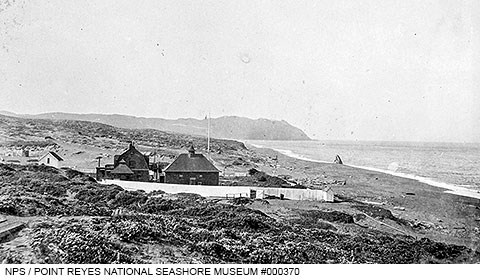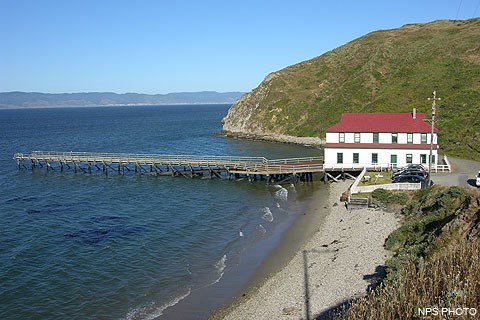|
How many prayers went unanswered along this prominent point? How many lives were lost and how many tears of sorrow fell for those who drowned in a cold dangerous sea? If you were fated to wreck along the rocky headlands or to beach in the pounding surf of Point Reyes Beach (aka, the Great Beach and Ten-Mile Beach), your cries for help and mercy would often be lost among the unrelenting waves of the Pacific. A Call to ActionBefore the establishment of Life Saving and Lifeboat Stations, the remains of vessels littered the beaches and the rocks along the United States coastline. Horrified spectators witnessed the drowning of passengers and crew, helpless to do anything. In the same waves that smashed hulls and took lives of the unsuspecting, some heard a call to action. Though organized, volunteer lifesaving (similar to volunteer firefighting) in the U.S. began in the 1780s, it was not until 1878 that a coordinated government agency was established to aid distressed mariners. The United States Life-Saving Service (USLSS) provided hope for those whose fate was once sealed by pounding ocean waves and foreboding coastlines of the United States. The USLSS was a model agency and its surfmen would earn a place in the hearts of Americans for their feats of bravery. 
A New Hope at Point ReyesIn 1890, the United States Life-Saving Service (USLSS) established a station at Point Reyes with a keeper and a crew of seven surfmen on a lonely stretch of the Point Reyes Beach, which was notorious for its pounding surf and bad weather. The surfmen patrolled the beaches of Point Reyes with an ever-vigilant eye, looking for shipwrecks and their desperate crews. They walked the beaches day and night, with the fog chilling them to the bone and the wind blasting sand at the unprotected skin of their faces. The surfmen's positions were poorly paid, difficult, and full of danger. 
When a wreck was found, the surfmen did what they did best, they saved lives. As a shipwrecked mariner, you could be assured that the surfmen's presence gave you a much better chance of survival. Equipped with a surf boat and breeches buoys, a keeper would determine the best way to aid those in distress. Using a surfboat with the eight surfmen rowing and the keeper steering, the crew of the lifesaving station would take the imperiled mariners back to shore. But there were times when the boat could not safely reach a wreck. In those instances the breeches buoy and Lyle gun were used. Using a small cannon called a Lyle gun, a line would be shot to the wreck. The breeches buoy—which was a life preserver ring with an oversize pair of canvas legs—would then be sent to the wreck to remove crew and passengers one at a time. In the early years of lifesaving at Point Reyes, the surfmen knew of danger. But it was not the isolation of the beach or the vast open ocean that they feared. It was the unrelenting, pounding surf that lay between. Strong surf could keep a rescue operation at bay for hours or capsize a surfboat, taking a man's life in a cold sea. In the first three years of operation, three surfman lost their lives while they honed their lifesaving skills in drills. These experiences resonated throughout the Life Saving Service in its motto "Ye have to go out but ye don't have to come in." 
Early LossesThe Point Reyes Life-Saving Service Station's first keeper was William L. Loch, who faced a difficult two years at the station. Three of the first seven surfmen assigned to the station left immediately after arriving, finding the conditions at Point Reyes Beach too rough and dangerous. Later, one surfman charged that Loch had tried to kill one of the surfmen; fellow surfmen attested to the fact that "we found the treatment of Captain Loch unbearable." On December 12, 1890, while the surfmen brought the station’s surfboat to shore after more than an hour's drill at sea, a "heavy breaker came in suddenly and turned her over with all hands, seriously injuring two men." Andrew Anderson and Fred Carstens had been caught under the boat and crushed; they were taken indoors and one of the crew was sent to get a doctor, but both men died an hour later. On March 4, 1891, surfman John Korpala died after a long illness without receiving any quality medical attention. Korpala had signed up for duty in San Francisco two months before, and had hidden a two-year-old lung illness from Keeper Loch. Loch attempted to treat the illness using a number of home remedies, including whiskey punch, which may have quickened the surfman’s demise. Anderson, Carstens, and Korpala were buried in an unmarked and unfenced plot in the dunes 500 feet from the station dwelling. According to the first surfman to resign from the Point Reyes USLSS station in 1891, Keeper Loch considered that "[the dead surfmen's] people would not assist and therefore he thought he would not do so himself." On March 1, 1893, a tragedy similar to that of Anderson and Carsten occurred when, in completing a boat drill on a moderate ocean, an unexpected heavy breaker came in and overturned the surfboat. Surfman George Larson was struck by a gunwhale and killed instantly. By the time of Larson's death, there was "much unfavorable comment" from visitors and "a very unpleasant impression" made on the crew by the unceremonious conditions under which Anderson, Carstens, and Korpala were buried. The surviving surfmen exhumed and gave the bodies to Captain Peter Henry Claussen, the tenant of the G Ranch, who took the remains to the Claussen family cemetery, where they, along with Larson, received a proper reburial. A New Name, a New Site, and New Technology
In 1915, the United States Life-Saving Service was combined with the U.S. Revenue Cutter Service to form the U.S. Coast Guard. This newly formed agency was now charged with aiding those in distress and interdicting smugglers. Very little changed in the first years under Coast Guard management, but, in 1927, operations moved from the Point Reyes Beach to the protected waters of Drakes Bay near Chimney Rock. At Chimney Rock, a new station was built as longer, heavier, motorized lifeboats replaced the old, human-powered surfboats. The size and weight of these boats meant that they had to be launched using a pier and a marine railway that descended from the boathouse to the water. Chimney Rock and the calm protected waters was a much safer place from which to launch rescues. With the calmer waters and its proximity to the headlands, the new faster boats had a greater command of the Point Reyes Peninsula. 
The Tragedy of Lifeboat #36542The move to Chimney Rock in 1927 relieved many who faced the dangers of the Great Beach surf, but lives risked and lost in the pursuit of saving others were not a thing of the past. After only two months at the new site, the men of the station responded to their first rescue saving the crew from a burning vessel. As the years passed and the Coast Guardsmen left their marks in the Station's logbooks, hints of their bravery can often found. Lifesaving crews risked their lives in rough seas, near the rocky headlands, and among towering waves saving the lives of many. In the process they lost two of their own. On the night before Thanksgiving in 1960, USCG crewmen Anthony Holmes and Hugh McClements left in Coast Guard Motor Lifeboat #36542 from Chimney Rock for a routine assist of a fishing boat near Bodega Bay. After securing the civilian vessel in her port, the crewmen radioed the lifeboat station that they would be returning in less than an hour. That was the last that was heard from the crew. When they did not return on schedule, the rest of the crew initiated a search. The lifeboat was found the next morning, having run aground on the Great Beach with the motor still running. Five days later the body of Holmes was found further south on the beach. On December 16, 1960, the body of McClements was found. What happened to the crew? The answer was lost with them, leaving a mystery in its place. Whatever the answer, there is no question of the surfman's bravery. Even with all these tragedies, the lives and vessel saved far outnumbered those lost by the duty bound. In the the well over a century of lifesaving at Point Reyes, countless vessels, their crews and passengers, and millions of dollars worth of ships and cargo have beensaved. 
Our Maritime Past and FutureEventually modern technologies eclipsed the need for the Lifeboat Station at Point Reyes. The quick response of larger, faster Coast Guard Cutters and helicopters have meant the need for fewer lifesaving sites and fewer staff. On December 16, 1968, the Point Reyes Lifeboat Station was decommissioned and transferred to the National Park Service in 1969. Much of this history and these lives lived in service to others are now gone. All that remains in its place is a building. Silent and decommissioned, it embodies all the perils endured, and all the lives saved that would have otherwise be lost forever. The Historic Lifeboat Station at Chimney Rock stands as a monument to their stories of service and sacrifice. These stations and those who staffed them fulfilled their roles in the development of coastal cities and industries. Today, the Historic Lifeboat Station at Point Reyes National Seashore is used as an educational facility for non-profit groups learning about the resources of the natural and cultural resources of Point Reyes. The building is visible from the Chimney Rock Trail and is sometimes open to the public on weekends and holidays from January to mid-March. For more information, please call the National Seashore at 415-464-5100. Check out our Chimney Rock page for more information about visiting this beautiful location. And check out our Point Reyes Record: Then & Now: U.S. Life-Saving Service photo gallery to compare historic photos with photos taken in 2019 from the same locations. And if you want to take a deeper dive into the history of the Point Reyes Lifeboat Station, download the 2006 Cultural Landscape Inventory. Photo Galleries |
Last updated: August 27, 2021
